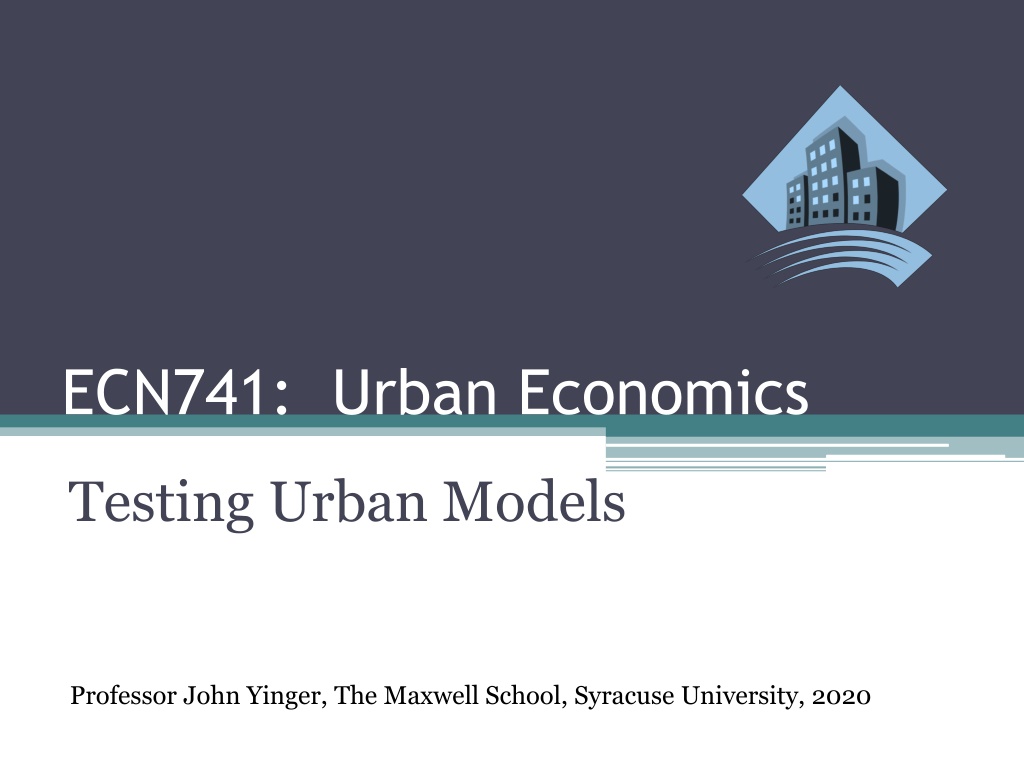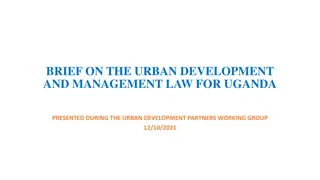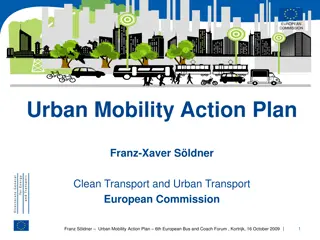Testing Urban Models: Approaches and Limitations
Dozens of studies in urban economics focus on testing various urban models by estimating land rent, density, and derived envelopes. However, limitations exist as many studies overlook theoretical derivation and fail to consider bidding and sorting along the envelope. This article discusses the challenges and outcomes of testing urban models, highlighting the importance of incorporating theory in deriving functional forms and interpreting coefficients correctly.
Download Presentation

Please find below an Image/Link to download the presentation.
The content on the website is provided AS IS for your information and personal use only. It may not be sold, licensed, or shared on other websites without obtaining consent from the author.If you encounter any issues during the download, it is possible that the publisher has removed the file from their server.
You are allowed to download the files provided on this website for personal or commercial use, subject to the condition that they are used lawfully. All files are the property of their respective owners.
The content on the website is provided AS IS for your information and personal use only. It may not be sold, licensed, or shared on other websites without obtaining consent from the author.
E N D
Presentation Transcript
ECN741: Urban Economics Testing Urban Models Professor John Yinger, The Maxwell School, Syracuse University, 2020
Testing Urban Models Approaches 1. Estimate P{u} 2. Estimate R{u} (land rent) 3. Estimate D{u} (density) 4. Estimate theoretically derived envelopes
Testing Urban Models Approaches 1. Estimate P{u} 2. Estimate R{u} (land rent) 3. Estimate D{u} (density) 4. Estimate derived envelope and bid functions
Testing Urban Models Dozens of studies include distance to CBD as an explanatory variable. Some include actual commuting time (available in the census), which is endogenous! Examples of recent studies that look at several different ways of measuring time or distance: Ottensmann, John R., Seth Payton, and Joyce Man. 2008. Urban Location and Housing Prices within a Hedonic Model. Journal of Regional Analysis and Policy 38 (1):19-35. Waddell, Paul, Brian J. L. Berry, and Irving Hoch. 1993. Residential Property Values in a Multinodal Urban Area: New Evidence on the Implicit Price of Location. The Journal of Real Estate Finance and Economics 7 (2) (September): 117-141.
Testing Urban Models Example: Ottensmann et al. These scholars identify many different measures of commuting time and distance. They compare models with different measures. No clear winner emerges. Their results are summarized in the following table (where TAZ = traffic analysis zone).
Testing Urban Models Limitations These studies do not use theory to derive functional forms. Moreover, many of them forget the most basic fact about an envelope: Moving along the envelope reflects both a change in bids from a given household type and a change from one household type to another: bidding and sorting! The coefficient of a time or distance variable does not indicate household willingness to pay for access to jobs. A point on a nonlinear envelope indicates a point on a household s marginal willingness to pay (i.e. inverse demand function) for access to jobs a point that depends on the nature of the existing market equilibrium. But a linear (or semi-log) envelope essentially assumes that no sorting exists and cannot be given a willingness to pay interpretation.
Household Heterogeneity Bid-Rent Functions and Their Envelope Envelope P{u} Bid Functions Commuting Distance = u
Testing Urban Models Approaches 1. Estimate P{u} 2. Estimate R{u} (land rent) 3. Estimate D{u} (density) 4. Estimate derived envelope and bid functions
Testing Urban Models Land rent summarizes the derived demand for land, and some studies estimate R{u} instead of P{u}. Example: D.P. McMillen, "One Hundred Fifty Years of Land Values in Chicago: A Nonparametric Approach," JUE (July 1996), pp. 100-124. These studies do not use theoretically derived functional forms.
Testing Urban Models Approaches 1. Estimate P{u} 2. Estimate R{u} (land rent) 3. Estimate D{u} (density) 4. Estimate derived envelope and bid functions
Testing Urban Models A huge literature, going back to the 1950s, estimates population density functions, D{u}. Fairly recent reviews can be found in: Small and Song, "Population and Employment Densities: Structure and Change," JUE, (November 1994), pp. 292-313. Anas, Arnott, and Small, Urban Spatial Structure, Journal of Economic Literature (September 1998), pp. 1426-1464 There is not much theory in this literature, apart from the (incorrect) derivation of the exponential form from an urban model, which we discussed in an earlier class.
Testing Urban Models Some informal theory is offered in the case of multiple worksites. The paper below identifies three assumptions: that different worksites are substitutes, complements, or somewhere in between. Heikkila, E., P. Gordon, J. I. Kim, R. B. Peiser, H. W. Richardson, and D. Dale-Johnson. 1989. What Happened to the CBD-Distance Gradient?: Land Values in a Policentric City. Environment and Planning A 21 (2): 221-232. Allocating each household to a worksite, as in the models discussed earlier, is an example of the first assumption.
Testing Urban Models Lots of room for more work on density with big data. Three-dimensional maps. How they change over time. How they correlate with job locations or transportation systems.
Testing Urban Models Another approach is to focus on light at night. Light is a sign of activity. Recent photographs from space show the lack of activity after a hurricane. Some studies look at light patterns to indicate economic growth as indicated by changes in density. Some city light pictures are on the following links.
Testing Urban Models See, also: https://earthobservatory.nasa.gov/images /77658/shanghai-at-night-a-growing-city https://earthobservatory.nasa.gov/images /79800/city-lights-of-the-united-states- 2012
Testing Urban Models Questions How should one interpret the coefficient of distance to the CBD in an empirical study of housing price determinants? What are alternative ways to measure commuting costs with one worksite? What is the difference between the complements and substitutes views of commuting costs with many worksites.
Approaches 1. Estimate P{u} 2. Estimate R{u} (land rent) 3. Estimate D{u} (density) 4. Estimate derived envelope and bid functions
As explained in the last class, it is possible to derive the hedonic envelope for access to jobs with a standard, but slightly modified approach to bid functions and an assumption about the hedonic equilibrium. This is the approach in my 2020 working paper, The Price of Access to Jobs. To the best of my knowledge, this approach is the first one to estimate the hedonic price function for access to jobs with heterogeneous households. Many studies recognize, of course, that observed prices reflect both bidding and sorting, but no previous study has been able to distinguish between these two components of observed prices.
One of the advantages of my approach is that it can shed light on the determinants of household sorting in two ways. First, recall that the sigma parameters describe the nature of the hedonic equilibrium. The central urban theorem with heterogeneous households is that sorting depends on bid-function slopes (i.e. that 2 is significant) and that households with steeper slopes live closer to jobs (i.e. that 2< 0 so long as 3 is positive). To the best of my knowledge, these tests are new.
Second, my method leads to a test of normal sorting. Once the 2s are estimated, I can use the (inverted) formula for the hedonic equilibrium to estimate the relative slope parameter, . Then I can use the expression for that appears in the bid-function to see how income affects bid- function slopes. A well-known theorem is that normal sorting arises if the income elasticity of commuting costs, , is smaller than the income elasticity of demand for housing, . By assuming that is constant, I can test this theorem directly.
Here is the algebra: m t = . m Y t ( ) Y t Y = m m C t ln{ } = + )ln{ } ln{ } ( a C Y So a negative coefficient for the Y term supports the normal-sorting hypothesis.
My data set contains all the house sales in the Cleveland metropolitan area in 2000 Including detailed data on Housing characteristics Neighborhood characteristics Location of jobs A key issues is how to measure access to jobs Straight-line distance or distance along streets? Time or distance? Access to center or access to job clusters? What do home buyers perceive? (Never directly observed!)
I examine several different time and distance measures. The ones I selected come from two sets: Measures that have the most explanatory power in a set of 9 time and 9 distance measures examined in a draft working paper by Carlos Diaz and me. Measures that play an important role in urban economic theory. The final set of measures is listed in the following table. One Diaz/Yinger finding to note is that in Cleveland in 2000, straight-line times and distances have more explanatory power than comparable along-the-street measures. Thanks to internet mapping programs, this may no longer be true.
Table 2. Measures of Job Access Panel A: Definitions Measure Distance Measures (in Miles) DIST1 Estimated actual commuting distance (straight line) DIST2 Straight-line distance to Terminal Tower DIST3 Employment-weighted straight-line distance to worksites DIST4 Straight-line distance to assigned worksite Measure Distance Measures (in Miles) DIST1 Definition Definition Mean Mean Minimum Minimum Maximum Maximum Uses tract-to-tract data 7.97 3.01 29.04 DIST2 From monocentric models 13.39 1.11 41.36 DIST3 Job sites as complements 13.20 7.27 39.52 DIST4 From models with CBD and SBD 6.92 0.01 42.25 Time Measures (in Minutes) TIME1 Actual commuting time TIME2 Estimated straight-line time to Terminal Tower TIME3 Employment-weighted straight-line time to worksites TIME4 Straight-line timer to assigned worksite Time Measures (in Minutes) TIME1 TIME2 Reflects congestion 25.87 11.11 46.53 44.51 9.87 87.48 TIME3 46.31 25.97 86.26 TIME4 32.33 4.24 121.39
Table 2. Measures of Job Access Panel B: Correlations Distance Measures Distance Measures DIST1 1.00 0.64 0.62 0.55 DIST2 DIST3 DIST4 DIST1 DIST2 DIST3 DIST4 DIST1 DIST2 DIST3 DIST4 1.00 0.97 0.71 1.00 0.79 1.00 Time Measures Time Measures TIME1 1.00 -0.03 0.10 0.28 TIME2 TIME3 TIME4 TIME1 TIME2 TIME3 TIME4 TIME1 TIME2 TIME3 TIME4 1.00 0.82 0.30 1.00 0.61 1.00 Cross Correlations Cross Correlations DIST1 0.26 0.63 0.57 0.34 DIST2 -0.01 0.99 0.86 0.35 DIST3 0.01 0.93 0.90 0.45 DIST4 0.19 0.67 0.70 0.67 TIME1 TIME2 TIME3 TIME4 TIME1 TIME2 TIME3 TIME4
I estimate the envelopes and bid functions using the following steps: Step 1: Estimate the hedonic Step 1A: Estimate a house sales regression with neighborhood (CBG) fixed effects. Step 1B: Estimate a hedonic for neighborhood traits, including access to jobs. Step 2: Estimate the bid functions Calculate (as explained earlier) and regress it on the determinants of a household s relative bid-function slope.
The regression in stage 1A has 22,880 observations (= house sales); the dependent variable is the log of house value. It includes: 17 housing traits (such as square footage, house age, and lot size), 18 variables to measure the difference in a location s traits (such as distance to an elementary school or to Lake Erie) between the house s actual location and the center of its CBG, and 1,665 CBG fixed effects. The R-squared is 0.7893. The neighborhood (=CBG) fixed effects are highly significant. Stage 1A Regression Please contact Professor Yinger for details regarding figures and graphs.
The regressions in stage 1B have 1,665 observations (= CBGs); the dependent variable is a CBG s fixed effect from stage1A (plus the constant). The regressions include 50 controls for locational traits (such as school quality, crime rate, aid pollution, access to parks) plus county and worksite fixed effects. This regression is conducted for each measure of job access. The R-squared values are all close to 0.70. Most of the control variables are statistically significant (with errors clustered at the school district level). Please contact Professor Yinger for details regarding figures and graphs. List of Control Variables
I start with linear, log, and quadratic specifications. The linear term is negative and significant for 7 of the 8 cases, but, as explained earlier, it does not identify any structural parameters. The log term is negative and significant in 5 of the 8 cases, but this result is consistent with both no time costs and no operating costs (and does not identify structural parameters). Both terms of the quadratic form are significant (negative and positive) for DIST1, DIST3, and TIME1.
Table 3: Access Envelopes Estimated with Simple Forms Table 3: Access Envelopes Estimated with Simple Forms Quadratic, 1st Term Quadratic, 2nd Term Linear Log Distance Measures (in Miles) DIST1 Distance Measures (in Miles) DIST1 Estimated actual commuting dist. (straight line) Coefficient t-Statistic Straight-line distance to Terminal Tower -0.00259 (-0.97) -0.05066 (-1.72) -0.02390 (-2.39*) 0.00075 (2.47*) DIST2 DIST2 Coefficient t-Statistic Employment-weighted straight-line distance to worksites -0.00830 (-3.64**) -0.10296 (-2.17*) -0.01492 (-1.49) 0.00014 (0.75) DIST3 DIST3 Coefficient t-Statistic Straight-line distance to assigned worksite -0.00946 (-4.42**) -0.20813 (-5.24**) -0.02919 (-3.34**) 0.00043 (2.29*) DIST4 DIST4 Coefficient t-Statistic -0.00449 (-5.53**) -0.01195 (-1.36) -0.00624 (-1.41) -0.00002 (-0.20) Dependent variable is CBG fixed effect; 1,665 observations; many controls included.
Table 3: Access Envelopes Estimated with Simple Forms Table 3: Access Envelopes Estimated with Simple Forms Quadratic, 1st Term Quadratic, 2nd Term Linear Log Time Measures (in Minutes) TIME1 Coefficient t-Statistic TIME2 Time Measures (in Minutes) TIME1 Actual commuting time -0.00307 -0.08781 (-2.77**) -0.01462 (-2.28*) 0.00021 (2.03*) (-2.77**) TIME2 Estimated straight-line time to Terminal Tower Coefficient t-Statistic -0.00498 -0.17443 (-2.93**) -0.00315 (-0.62) -0.00002 (-0.44) (-2.06*) TIME3 TIME3 Employment-weighted straight-line time to worksites Coefficient t-Statistic -0.00437 -0.18173 (-5.06**) -0.00188 (-0.44) -0.00003 (-0.61) (-4.72**) TIME4 TIME4 Straight-line time to assigned worksite Coefficient t-Statistic -0.00094 -0.02033 (-2.05*) -0.00069 (-0.59) 0.00000 (-0.25) (-1.68) Dependent variable is CBG fixed effect; 1,665 observations; many controls included.
Then I turn to my specification with different assumed values for the key parameters that are available in the literature: 3= , 1, and 2 = 0.3 and 1.0 (based on the literature) plus 1.5 (needed for a solution when 3 = 2) = 0.3 and 1.0 (based on the literature) This leads to 14 cases (not 18 because = 1.5 is required when 3= 2).
The results are significant (5% level) with the expected negative sign in every case for DIST1, DIST3, and TIME1 and only once for the other 5 measures of job access. The results imply that the price of housing at the location with the least-valued access compared to the location with the best access is about 12% lower for DIST1, 26% lower for DIST3, and 34% lower for TIME1. These results for DIST1, DIST3, and TIME1 strongly support the theorem that household sorting depends on the slopes of household bid functions.
Table 4. Illustrative Access Envelopes Estimated with Theoretically Derived Forms (Part A) Assumed Value of Access Measure 3 DIST3 Table 4. Illustrative Access Envelopes Estimated with Theoretically Derived Forms (Part A) Estimated Value of Access Measure DIST3 R- Squared 0.7016 1 2 0.3 0.3 0.5 1083.64 (4.22**) 33.66 (6.60**) 5.88 (11.20**) 298.73 (8.22**) 16.55 (13.75**) -200.77 (-2.27*) -4.38 (-2.39*) -0.48 (-2.47*) -274.03 (-2.76**) -10.17 (-2.60**) -1.40 (-2.51*) DIST3 DIST3 0.3 1.0 1.0 0.7018 DIST3 DIST3 0.3 1.5 2.0 0.7019 DIST1 DIST1 1.0 1.0 0.5 0.6967 DIST1 DIST1 1.0 1.5 1.0 0.6967 DIST1 DIST1 1.0 1.5 2.0 4.00 0.6966 (24.03**) Dependent variable is CBG fixed effect; 1,665 observations; many controls included.
Table 4. Illustrative Access Envelopes Estimated with Theoretically Derived Forms (Part B) Assumed Value of Access Measure 3 DIST1 (IV) Table 4. Illustrative Access Envelopes Estimated with Theoretically Derived Forms (Part B) Estimated Value of Access Measure DIST1 (IV) R- Squared 0.6723 1 25.08 (1.98*) 1207.76 (7.12**) 34.93 (12.13**) 2 -6.04 (-1.00) -577.41 (-2.15*) -10.93 (-2.10*) -1.09 (-2.09*) -1847.04 (-2.33*) -3591.63 (-1.26) 1.0 1.0 1.0 TIME1 TIME1 1.0 0.3 0.5 0.6963 TIME1 TIME1 1.0 1.0 1.0 0.6962 TIME1 TIME1 0.3 1.5 2.0 5.92 0.6952 (22.17**) -72723.48 (-34.70**) 1932.34 (2.05*) DIST2 DIST2 0.3 1.0 0.5 0.7004 DIST4 DIST4 1.0 1.5 0.5 0.6989 Dependent variable is CBG fixed effect; 1,665 observations; many controls included.
These results also contain a surprise: The envelopes turn up when job access is poor. Although it applies only to a few observations (16 to 59 out of 1,665), this result obviously needs explanation. This turn-up is not created by my functional form. It also appears in the related quadratic specifications. It suggests that models of access to jobs may be missing something: Perhaps long commutes have greater reliability or some other trait that household value and that is not accounted for by distance or time alone. Or, despite my data gathering efforts, I may have omitted a non-transportation locational trait that is correlated with long commutes (in distance and time!).
Figure 3. Access Envelopes for Various Access Measures Panel A: Distance Measures with = = 3 = 1
The most likely candidate for a missing variable is speed. Recall that operating costs associated with distance assume that speed is constant. In fact, speed increases with distance (in theory and in my data). One way to address this issue is to assume that DIST1 is measured with error (relative to what home buyers perceive) and to estimate the model with instruments. This approach greatly diminishes the turn-up but does not eliminate it. Moreover, the turn-up also appears to a much smaller degree with TIME1, And good instruments are difficult to find. Please contact Professor Yinger for details regarding figures and graphs. Instruments
Figure 3. Access Envelopes for Various Access Measures Panel B: Distance and Time Measures with = = 3 = 1
DIST3 has the highest explanatory power of any job- access measure, although the differences are not significant. The envelopes for DIST3 are very similar for various values of the assumed parameters. The turn-up for DIST3 affects very few observations. This result supports the complements approach to multiple worksites not the substitutes view in urban models. An urban modelling opportunity!
Figure 4. Access Envelopes for DIST3 Panel A. Envelopes with 3 = 1
Figure 4. Access Envelopes for DIST3 Panel B. Envelopes with = 0.3 and = 1.5
As explained earlier, my approach yields an estimate of the relative slope of a bid function, , which makes it possible to estimate the determinants of this slope. One determinant of this slope is income; a negative coefficient for income indicates normal sorting. I have two sources of income data HMDA data, which give income for people actually buying housing, who are in my sales data set. These data cover the right people but are only available by tract and only include a few household traits. Census data, which gives CBG characteristics. These data have many household traits, but cover all the people in a CBG, not just new buyers.
The results strongly support normal sorting for DIST3; the coefficient of income is negative and significant regardless of the income measure. In the case of DIST1, the income coefficients are negative and significant for the Census income measure but not for the HMDA income measure. In the case of TIME1, the income coefficients are negative and significant for the Census income measure and negative and weakly significant (5 of the 14 cases at the 5% level) for the HMDA income measure.
Table 5: Illustrative Normal Sorting Tests Assumed Value of Income Coefficient for: DIST1 Data Source 3 DIST3 TIME1 HMDA 1.0 0.3 0.5 -0.0893 (-3.45**) -0.1035 (-5.76**) -0.1006 (-4.62**) -0.0760 (-4.11**) -0.1962 (-5.57**) -0.2620 (-6.41**) -0.2786 (-5.93**) -0.1267 (2.37*) 0.0351 (1.48) 0.0075 (0.28) 0.0159 (0.55) -0.0484 (-1.71) -0.0614 (-2.05*) -0.0544 (-1.85) HMDA 0.3 0.3 1.0 HMDA 1.0 1.0 1.0 Full Results HMDA (IV) 1.0 1.0 1.0 Please contact Professor Yinger for details regarding figures and graphs. Census 1.0 0.3 0.5 -0.1961 (-3.88**) -0.2609 (-4.35**) -0.2953 (-4.67**) -0.1709 (-2.37*) -0.1882 (-2.58**) -0.1858 (-2.49*) Census 0.3 0.3 1.0 Switching Model Census 1.0 1.0 1.0 Please contact Professor Yinger for details regarding figures and graphs. Census (IV) 1.0 1.0 1.0 The dependent variable is an estimate of ; there are between 1,606 and 1,649 observations; household traits are included as controls.
My paper is the first to estimate job-access bid functions and envelopes with heterogeneous households. Linear and log specifications cannot estimate structural parameters of the hedonic equilibrium. The form I derive provides significant structural parameters using 3 different job-access measures: DIST1, DIST3, and TIME1. The results support the hypothesis that household sorting depends on bid-function slopes The results support normal sorting under most, but not all circumstances. slopes.
The results in my paper leave may questions unanswered. Why do such different measures of job access have similar explanatory power? Do other theoretically based functional forms yield significant structural parameters with job-access measures other than DIST1, DIST3, and TIME1? Is the complements view of job access supported by estimated envelopes in other metropolitan areas? Have perceptions of job access changed with the advent of mapping software? Is the upward turn in bid-function envelopes an important behavioral issue or simply a flaw in my theory or methodology? Why does normal sorting arise with some measures of job access (with some measures of income) but not others?
Appendix Table B3. Illustrative Regression for DIST1 Definition Regression Based on HMDA Data (by Census tract) Variable Coefficient t-Statistic lav_inc ploan_blk2 ploan_his2 ploan_sinm ploan_sinf ploan_cupm ploan_cupf ploan_fha ploan_vet fillin constant Dependent variable is estimated ; 1,640 observations (omitting 25 observations with negative ); standard errors are clustered at the school-district level; significance: * = 5%; ** = 1%; assumed values for exogenous parameters are = = 1 and 3 = 0.5 Log of average HMDA income Pr(Buyer is African-American) Pr(Buyer is Hispanic) Pr(Buyer is single male) Pr(Buyer is single female) Pr(Buyer is male couple) Pr(Buyer is female couple) Pr(Buyer uses FHA loan) Pr(Buyer uses VA loan) HMDA data missing -0.0834 0.1054 0.2655 0.0823 -0.1019 0.0890 0.0422 0.0592 -0.4218 -0.0854 0.1192 (-4.39**) (4.92**) (5.85**) (3.28**) (-2.37* ) (1.77 ) (0.69 ) (3.19**) (-1.16 ) (-1.84 ) (1.50 ) Please contact Professor Yinger for details regarding figures and graphs.
The main sorting results are based on the downward-sloping regions of the estimated envelopes. The few observations (between 16 and 59) on the upward sloping regions are simply dropped. Another possibility is to estimate an endogenous switching model in which households select one of these regions and then have demand for job access within the region they select. These models do not converge using DIST3, but sometimes yield results using DIST1 and TIME1.























